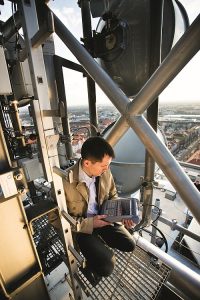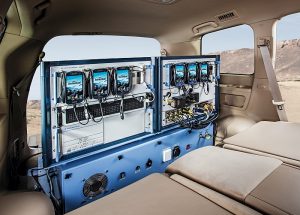- Projects of the future such as the Internet of Things, enhanced mobile broadband and self‑driving cars require extreme mobile network performance.
- 5G, the next generation of mobile communications, is expected to deliver the necessary performance.
- But thanks to continual technological enhancements, in particular LTE / LTE-Advanced networks provide an excellent evolution path. Here an overview.
- This article of Meik Kottkamp from Rohde & Schwarz describes how immense data volumes are being transmitted today and how mobile network operators are ensuring that they can offer their subscribers an excellent quality of experience in the future.
If we take the 1990 specifications freeze for the 900 MHz GSM standard as zero hour, digital wireless communications has just celebrated its 25th birthday. There is, however, no sign of slowing down – far from it in fact. The hunger for data in cellular communications remains insatiable and the demand for further technological progress persists. A tenfold increase in mobile data traffic is expected over the next six years, and experts predict an exponential increase in the number of things (Internet of Things, IoT) that communicate with each other via mobile networks. The Ericsson Mobility Report details that the total number of mobile subscriptions at the end of 2015 was around 7.3 billion (including 1 billion LTE subscriptions), an increase of 68 million subscriptions during Q4/2015 (e.g. 21 million in India, 6 million in China, 5 million in the US, 5 million in Myanmar and 3 million in Nigeria). Mobile subscriptions are forecast to reach 9.1 billion by late 2021. In 2015, the average smartphone user consumed 1.4 Gbyte of data monthly. This is expected to rise to 8.5 Gbyte by 2021. The combination of these two factors will result in exponential data traffic growth around the world.
2G / 3G / 4G technologies and future improvements
Looking at the different 2G (GSM, GPRS, EDGE), 3G (UMTS, HSPA, HSPA+) and 4G (LTE / LTE-Advanced (LTE‑A)) mobile technologies, it becomes clear that the introduction of new transmission methods on the air interface between base stations and wireless devices as well as the optimization of the mobile network architecture have resulted in significant improvements. The theoretically achievable data rate per device has evolved from a few 100 kbit/s (EDGE) to 42 Mbit/s (HSPA+) to several hundred Mbit/s (LTE / LTE‑A). State‑of‑the‑art, commercially available LTE‑A devices achieve 600 Mbit/s in ideal lab environments. In a real network, propagation conditions and the shared channel principle reduce achievable download speeds due to the fact that available bandwidth is divided among all active subscribers. Nonetheless, LTE / LTE‑A technology has significantly enhanced available data rates and network capacity.
The following innovations have been essential to this achievement:
- A wide system bandwidth of 20 MHz that can be provided to an individual subscriber as well as the ability to bundle up to five of these 20 MHz carrier frequencies for each subscriber (commonly known as carrier aggregation, CA). CA is the most significant improvement within LTE-Advanced in 3GPP Release 10.
- Use of spatial multiplexing (MIMO technology), i. e. using anywhere from two to eight/four transmit/receive antennas.
- Fast OFDMA multiplexing, i. e. the frequency and time resource allocation can be changed on a millisecond basis. The smallest resource that can be allocated to a wireless device is a resource block (RB) with a frequency of 180 kHz and a time duration of 0.5 ms.
- High‑quality modulation methods, specifically QPSK, 16QAM, 64QAM and 256QAM.
A lean network architecture and pure packet-switched data transmission enable short network response times. LTE smartphones load Internet pages much faster than with older technologies.
Introducing LTE / LTE‑A has allowed network operators to meet increasing demands. The success of this technology can also be seen in the fact that 494 commercial networks have been implemented in 162 countries around the world since the first commercial LTE network was launched in late 2009 (source: Global Mobile Suppliers Association (GSA), April 2016). The following section explores several key LTE improvements resulting from enhancements introduced by the 3GPP standardization body (as of Release 10, LTE is also referred to as LTE‑Advanced or LTE‑A).
LTE features a specific enhanced multimedia broadcast multicast service that makes it possible to allocate the same resources (frequency and time) to multiple subscribers within a cell. This is a highly efficient method of addressing mobile TV applications, for example, where many subscribers receive the same data simultaneously. This mode also allows wireless devices to install new software efficiently – a task that generally still takes place via individual data connections for each device.
Since WLAN is implemented in almost all wireless devices, WLAN connections are available in private homes and in many public locations. Many mobile network operators set up hotspots in exposed areas such as airports to provide an alternative means of accessing the Internet. The user of the wireless device can simply turn the WLAN function off and on to gain access. Some wireless devices also feature a dedicated application that automatically switches the device’s data connection to WLAN as soon as it detects a hotspot with sufficient performance. In such cases, all data traffic is routed either via the mobile network or WLAN. In the 3GPP specifications, a special mode is available to use, for example, an email application running in the background via WLAN while transmitting video data via LTE. However this has not (yet) been adopted in commercial networks. Generally, network operators gain considerably more flexibility when using WLAN and LTE and can provide their subscribers with higher data rates and more capacity. As an alternative, operating LTE / LTE-A in unlicensed frequency bands is enabled (licensed-assisted access, LAA) and included in 3GPP Release 13 (approved in March 2016). Instead of switching from LTE to WLAN, LTE is used, for example, in the unlicensed 2.4 GHz ISM band and the data rate capability is increased using the carrier aggregation feature. A listen-before-talk function is added to LTE to avoid conflicts and ensure that access to bands is granted only when sufficient capacity is available. Finally, aggregation of data from LTE and WLAN on IP layer is possible, as well as a closer integration of WLAN and LTE cells by exchanging radio parameters between the access schemes. Therefore, 3GPP provides complementary solutions using WLAN and LTE technology. Commercial deployments will decide whether and which of these solutions will be adopted.
LTE networks use the same frequency in every cell, which leads to intercell interference at cell boundaries. A wireless device with an active connection to a base station receives the signals of the neighboring cell’s base station, which is sending signals to its connected devices. This causes interference and lowers achievable data rates, an effect that especially impacts heterogeneous network environments, i. e. network topologies in which multiple small (femto or pico) cells are operated within a large (macro) cell. Pedestrian zones are a good example. Small, high‑capacity hotspots cover high-traffic areas, yet they may also be within the receive range of a higher‑level cell that covers parts of the city. Coordinated multipoint transmission and reception (CoMP) was introduced to counteract this effect. CoMP makes it possible to transmit a signal to a wireless device at the cell boundary in a coordinated manner. There are various ways of implementing this coordination. In the simplest case, it is merely decided which of the potentially available base stations is to be used for transmission. Other options include allocating resource blocks for wireless devices or directing the antenna beams of the base stations involved to minimize interference. Using MIMO technology and also influencing the baseband signal (precoding) in a coordinated manner allows optimal coverage at cell boundaries. An additional technology component named dual connectivity has been specified in 3GPP Release 12 to offer further improvement for heterogeneous networks. The wireless device is configured for connection to two base stations on two different carrier frequencies. The master base station (eNodeB in LTE) supplies the higher‑level macro cell, and the slave eNodeB supplies the hotspot, i. e. a pico or femto cell. In this configuration, the master eNodeB uses parameters such as cell traffic and device speed to decide to use the macro cell or the hotspot for the data connection. Switching between the two is extremely fast and requires no additional signaling. This saves signaling capacity and minimizes handover errors. In wireless devices, interference at cell boundaries can be countered by employing improved receivers that recognize these specific types of interference and use appropriate algorithms to remove them from the received signal. Additional information about potential interference can also be provided by the network to improve such calculations. In the LTE standard, these technology components are called further enhanced intercell interference coordination (feICIC, included in 3GPP Release 11) and network assisted interference cancellation and suppression (NAICS, included in 3GPP Release 12).
The introduction of device‑to‑device (D2D) capabilities is of special importance, as these provide two fundamental new functions. First, the network-supported discovery function makes it possible for two spatially neighboring wireless devices to detect each other. Second, these devices and others in their vicinity will be able to exchange data directly, i.e. without going through the base station covering the area. However at least for the in-coverage case, i. e. if at least one device is located within cellular coverage, the whole process is authenticated and configured by the network. The introduction of this completely new functionality was primarily motivated by public safety considerations. Fire‑service and police applications need to exchange large amounts of data (images, videos) within small groups of individuals, some of whom may be located outside network coverage areas, e. g. in the basement of a burning building. Exchanging data between wireless devices connected in this manner will initially be limited to public safety and security applications. Initially, use by the general public will be confined to application‑related broadcast services. Other commercial usage models are conceivable and are also under discussion as part of the 5G development process. In particular automotive use cases are applicable, i. e. potentially supporting autonomous driving.
Even though LTE / LTE‑A networks are increasing in performance, comprehensive 4G coverage will take time. Efficient handover to 2G and 3G technologies remains critical. There are also many use cases where low data rates are sufficient. Here, the focus is on cost-efficient solutions with long battery life. In such machine‑to‑machine (M2M) environments, modules with e. g. GPRS technology designed to last years are often used. However, LTE /LTE‑A has already ushered in several improvements to serve M2M applications. For example, there is a category 0 for LTE user equipment that reduces the effort required to implement this class of devices (lower data rate requirements and no MIMO support). Processes have also been introduced to prevent mobile network overloading when large numbers of M2M devices attempt to access the network at the same time. Reducing the complexity was further progressed in 3GPP Release 13. The new UE category M supports only 1.4 MHz bandwidth and a maximum output power of only 20 dBm. Narrow-Band IoT (NB-IoT) describes a specific mode supporting only 180 kHz bandwidth, while in downlink the known 15 kHz sub-carrier OFDMA scheme is maintained, but in uplink a fairly new 3.75 kHz sub-carrier single-tone transmission SC-FDMA scheme is added. Coverage enhancements through repetition of channels can be realized, too.
In summary, for the time being LTE / LTE‑A technology covers the increasing requirements of mobile data traffic as well as M2M / IoT. Enhanced mobile broadband and IoT are also major use cases of the comprehensive discussion taking place on the next generation (5G). What is motivating the industry to introduce a new generation of mobile communications as early as 2020 (or even 2018 on a regional basis)? First, due to the constantly increasing number of subscribers and data rates, even LTE / LTE‑Advanced with all of their enhancements will not be able to cover the demand in the long term. Second, the definition of a new industry-wide use case class to significantly improve mobile network latency. These use cases will at least partly require extremely secure and reliable connections. It will then be possible to use cellular communications in the automotive industry (e. g. supporting autonomous driving) and in Industry 4.0 applications, opening up new sources of revenue. Latency requirements in the 1 ms range are impossible to implement with LTE/LTE‑A. In addition to technology‑based arguments, the previous development cycle indicates that the next technological step will take place in 2020. GSM was introduced in 1990, UMTS in 2000 and LTE in 2010. By the way, it should be mentioned that the 2020 Olympic Games will be hosted by Japan – a country that is heavily involved in the development of 5G (naturally not only for this reason).
Research institutes and development departments in major wireless communications companies are already conducting extensive studies in the field of 5G technology. These efforts are primarily dedicated to four technology blocks, which are being discussed as the solution for future requirements. Initial research efforts will identify which additional frequency bands can be made available by substantially increasing the bandwidth. This research covers the spectrum up to 100 GHz with bandwidths up to 2 GHz. Here, the significantly changed channel propagation conditions play a key role. Researchers must analyze these conditions before they can develop and evaluate appropriate channel models to assess new technologies (the next article shows how to analyze potential channels). The use of large numbers of transmit and receive antenna elements (order of magnitude: 100) is also under evaluation. They can be used to increase data rates in the frequency spectrum below 6 GHz through advanced MIMO techniques. In the high frequency range, they are necessary to provide the antenna gain required to achieve appropriate cell sizes. New air interface technologies are being discussed in connection with significantly higher frequencies and as a way to enable extremely short reaction times. Some of these interfaces have additional filter functions based on the OFDM technology implemented in LTE. Examples include universal filtered multicarrier (UFMC), filter bank multicarrier (FBMC), generalized frequency division multiplexing (GFDM) and filtered (sometimes called flexible) OFDM (f-OFDM). A more efficient network topology is also being looked into, a topology that is already starting to be used today. The fundamental idea is to design software functions that are specific to mobile communication nodes and to implement them on open hardware platforms. This would make it possible to more affordably implement e.g. enhanced packet core (EPC) node functions in mobile core networks as well as baseband functions of base stations. It would also enable operators to move these functions to alternative platforms in the case of a hardware failure. Ultimately, the processes will be similar to those already in place in data centers today. Network function virtualization (NFV) and software defined networking (SDN) as well as network slicing are helping drive the flexible implementation of these functions in mobile networks. It should be noted that security aspects are extensively discussed in this context.
Summary
The high performance of LTE / LTE-A technology, its seamless cooperation with existing 2G / 3G networks and the use of unlicensed spectrum complementary to WLAN enable network operators to meet their subscribers’ continuously growing big data requirements. Broadcast / multicast solutions enhance system flexibility. M2M applications are already playing a major role. The increasing number of things that will be communicating with each other in the future (IoT) and new demands stemming from vertical branches of industry (automotive industry, health care, robot control, etc.) are expected to dictate a need for further significant enhancements. That is why research and pre-development in the mobile communications industry is already discussing 5G as they look toward 2020 and beyond. Rohde & Schwarz and its subsidiaries SwissQual and ipoque offer a comprehensive portfolio for today’s T&M tasks and are actively involved in 5G research and development.
How does T&M equipment contribute?
Test and measurement equipment plays a central role in both introducing new technologies and in operating networks. Countless test solutions are required to develop and manufacture mobile devices, components, base stations and switching nodes. Test solutions are also needed when deploying the network and verifying its performance.
First, network operators have to select the right infrastructure products to operate their networks. Using instruments such as signal generators and signal and spectrum analyzers, they can qualify infrastructure products in order to select those that perform best. The Global Certification Forum (GCF) defines a broad range of tests as a prerequisite for wireless device certification. Many operators specify additional tests based on their specific network requirements. T&M equipment such as the R&S®CMW500 wideband radio communication tester emulates all required network functions and verifies whether a wireless device is behaving properly (functional test of implemented protocols) and whether the hardware is correctly implemented (e.g. it complies with the specified maximum transmit power). Fig. 1 shows suitable conformance test systems, such as the R&S®TS8980.
When deploying base stations in the field, compact testers are needed that can be used to quickly verify whether regulatory requirements are being met (Fig. 2). Following deployment, operators need to adjust parameters, such as handover thresholds, and identify coverage gaps in order to optimize their network and ensure the best possible data rates. Fig. 3 shows a drive test solution for effective mobile network planning. QualiPoc from SwissQual implements a measurement application on a commercial smartphone. The test solution can be used like a normal app, enabling network operators to evaluate end user experience. In the operator’s core network, where all data streams are processed, it is increasingly important to be able to analyze data traffic down to the packet level. This makes it possible to classify the data traffic and optimally route a service’s data packets through the network. IP analysis technology from Rohde & Schwarz subsidiary ipoque provides this insight. The same functionality is also of great interest for mobile device testing. When implemented on the R&S®CMW500, users can analyze which IP data streams (including protocols used) a smartphone maintains only due to applications running in the background.
There can always be unforeseen interference when operating mobile networks. Stationary network monitoring tools in the mobile network and mobile interference hunting solutions are used to identify and eliminate this interference as quickly as possible. For example, malfunctioning neon signs can create interference in a base station’s receive band and negatively impact all data traffic in a cell. Fig. 4 shows a technician using a mobile measuring receiver and a directional antenna to locate interference sources.
Even today, signal generators and signal analyzers are used to evaluate potential 5G components. They are indispensable due to their flexibility in terms of frequency range, bandwidth and transmission technology. They are also essential components of measuring systems used to analyze propagation conditions in new, undefined frequency bands (see next article). Multiport network analyzers will play a decisive role in implementing future antenna technologies. And finally, the influence of individual applications on data rates, signaling loads and current drain are under examination. This will be especially important for IoT modules as it must be possible to measure individual applications on the IP layer itself.
Fig. 1: RF and protocol testing systems help network operators select suitable wireless device providers. The test solutions ensure that the devices comply with mobile network standards.
Fig. 2: Cost‑efficient mobile T&M equipment is used to install a
base station.
Fig. 3: Network operators use T&M equipment to analyze network performance and optimize the end user experience.
Fig. 4: Mobile measuring receivers with directional antennas help operators monitor operational networks and identify interference.











